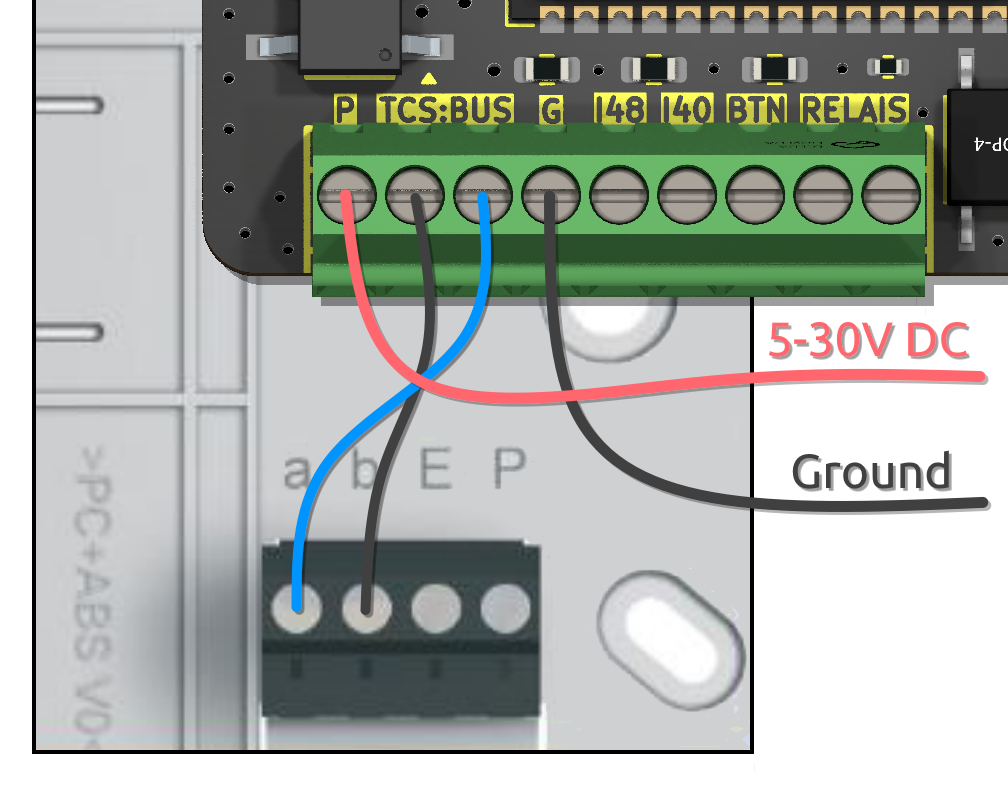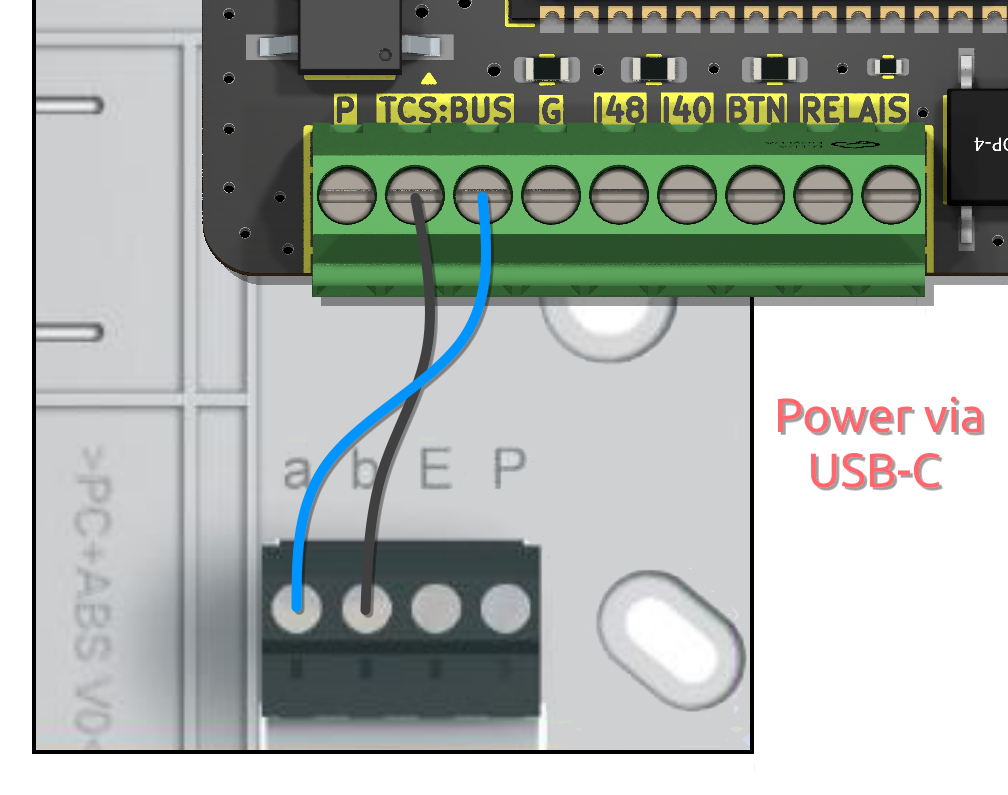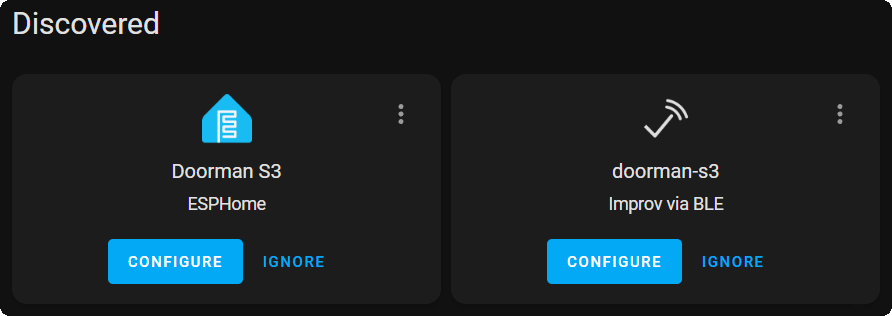Getting Started
Is this your first time here? Don't worry, we've got you covered! Below, you'll find a detailed guide for setting up your Doorman for the first time.
Please note that these instructions are based on the pre-flashed Doorman PCB that I sell. If you've had a PCB manufactured yourself, make sure to flash the firmware first; otherwise, you might be waiting a long time for anything described below to happen. 😄
Thank you so much for using Doorman! ❤️
Wiring
First, open your indoor station enclosure. On most models, you will find a screw terminal labeled with a, b, E, and P.
DANGER
NEVER CONNECT AN EXTERNAL POWER SOURCE TO THE TC:BUS TERMINALS
DOING SO CAN CAUSE SEVERE DAMAGE.
Connect the b line (Ground) to one of the TC:BUS terminals on your Doorman, and connect the a line (24V Bus) to the other TC:BUS terminal on your Doorman. Doorman is just like any other device on the bus, connected in parallel.
NOTE
By default, I ship version 1.5 with a jumper cap on BUS PWR. Please remove this if you are not connecting Doorman in the 2-Wire Mode via indoor station configuration.
Power supply options:
3-Wire Mode via indoor station Recommended
Connect the P line (+24V) to the P terminal on your Doorman.
WARNING
The intercom power supply must provide at least 60mA.
Example: 
2-Wire Mode via external wired Power Supply
Connect the external power supply to your Doorman using the P (+5V to +30V) and G (Ground) screw terminals.
Example: 
2-Wire Mode via external USB-C Power Supply
Connect the external power supply via the USB-C port.
Example: 
2-Wire Mode via indoor station Hardware revision 1.5 and later
Important Info
Using the a-bus line as a power source on revisions older than 1.5 results in a loud beeping noise. This issue is likely due to the high-frequency switching power supply.
Starting with revision 1.5 this method will only produce a subtle, yet noticeable hissing sound on the speaker.
After connecting the a and b lines, you need to connect BUS PWR using a jumper cap.
Example: 
Setup
Step 1: Connect to Wi-Fi
When you power on your Doorman-S3 for the first time, it will blink rapidly (orange) and create a new Access Point named Doorman-S3 Setup. You can set up your WiFi credentials using the Access Point, Improv Serial, or Improv Bluetooth.
The Access Point password is open-sesame.
Once connected to the Access Point, the web interface should open automatically (see also login to network notifications).
If it doesn't, you can manually navigate to http://192.168.4.1/ in your browser.
TIP
You can take advantage of automatic setup in Home Assistant if your Home Assistant has Bluetooth enabled.
Additionally, with mDNS support, Home Assistant will automatically discover your Doorman once it's connected to WiFi.

Step 2: Connect to Home Assistant
After connecting Doorman to your network, it will blink slowly (blue) and should be automatically discovered by Home Assistant. Simply click on Configure to add the newly discovered ESPHome node.
Step 3: Interactive Setup
TIP
When you first connect your Doorman to Home Assistant, it will be in Setup Mode for interactive setup already.
You don't need to manually activate this mode; it will start automatically at each reboot as long as the setup process has not been completed or canceled.
Access the Settings:
Open the settings either through your Doorman's Webinterface or visit the ESPHome Integration page and select the Doorman S3 device.Activate Setup Mode:
Go to theConfigurationsection and enableSetup Modeto begin the interactive setup.
Once the setup process begins, the RGB status LED will pulse green-turquoise.
BEFORE YOU PROCEED
The indoor station must be connected, and the enclosure securely closed, to complete the setup process.
Wait until you ring the doorbell:
When you press the doorbell button at your apartment or entrance, the system will save your indoor station's serial number and attempt to detect the model.Once the model is successfully detected, the system will read the memory of your indoor station. Note: This entire process can take up to 30 seconds.
If the model detection is successful or if it times out, the setup will be considered finished.
Setup complete:
The LED will remain green-turquoise for 3 seconds, then turn off, and the setup mode will be turned off. The setup is complete.
If you have multiple door stations, the firmware will attempt to automatically detect the additional station. To enable detection of the second doorbell and the ability to unlock the second door, you need to press the second doorbell or physically push the unlock button for the second door at least once to store its address.
MULTIPLE INDOOR STATIONS
If you have multiple indoor stations, things become a bit more complex. You'll need to create a custom YAML configuration to integrate all the indoor stations. The default firmware only supports a single indoor station.
ESPHome adoption
If you want to customize your Doorman firmware, you can add the Doorman device to your ESPHome Dashboard and flash your customized Stock or Nuki Bridge firmware.
After adding the device, your configuration will look like this:
Example
NOTE
You can add new components and modify existing ones here. For more information on the possibilities, check out the Examples section.
If you need to deeply customize the firmware, you'll need to use the base.yaml file from the repository.
# Doorman S3 Firmware
substitutions:
name: "doorman-s3"
friendly_name: "Doorman S3"
# Import Doorman Stock Firmware Config
packages:
AzonInc.Doorman: github://azoninc/doorman/firmware/configurations/esp32-s3.ha.stock.master.yaml@master
wifi:
ssid: !secret wifi_ssid
password: !secret wifi_password